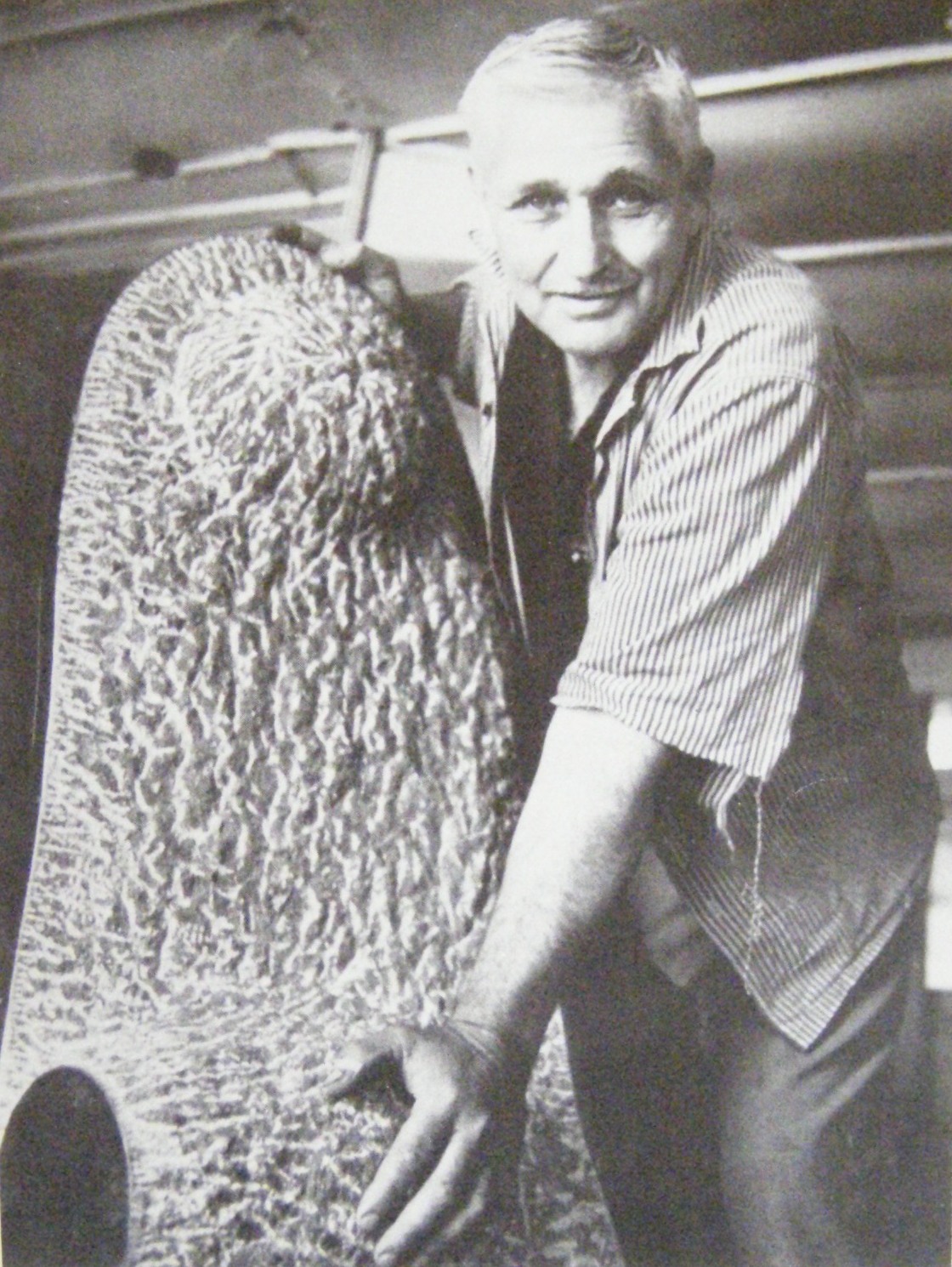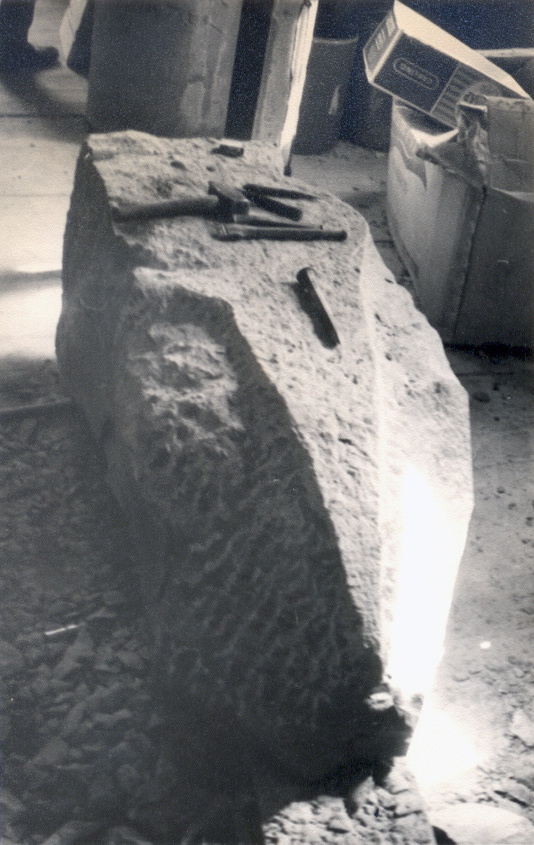His life, his art
“What inspires me is nature:
its terrible immensity, huge and always in motion…
I have only one hope:
expressing, incarnating, capturing this emotion and, for how much possible, communicating it to the others…”
He was a canadian sculptor, and was born in Moers (Germany) on 10 February 1909 by Dutch father and German mother. The family emigrates to western Canada West, near Duhamel, Alberta, when he is 5 years. Growing up on a farm, he makes his first education in direct contact with nature, that he feels deeply. At the age of twelve years he begins to paint images of the house of the peasants of his country using brushes and colors home made. In ’23 he works threshing the grain fields, in order to earn the money with which being able to buy a box of colors and a violin.
Quickly the artist feels itself called to the music and to the art, and studied with commitment violin, the favorite instrument. In ’27 the family sells the farm and returnes to Europe, where the artist continues to study violin and practices in the painting and sculpture.
In Kassel he plays in cafes, and in local theater. In this period the artist sees for the first time the museums and begins to make copies in order to exercise the hand. In the 30’s, at the age of twenty one years, he comes back to Canada, in Montreal, where he must face a hardest period for the serious economic crisis then in place. He continues to play in cafes, in concerts, in cinemas, ore anywhere is possible to earn something, and meanwhile he paints continuously, with the figurative language, especially fixing landscape images. In 1934 has the first exhibition of his paintings at the library “Top of the Hill” on Beaver Hall Hill in Montréal: his works represented canadian landscapes.
At that time Noordhoek has a strong interest in the astronomy and makes a powerful telescope with which investigates the spaces. This experience is in no way secondary in the artist’s world of searches, since it has largely influenced the outcome of his current work. The war marks strongly the artist, which commits precious years enlisted into the Canadian army.
In ’50 makes a long study trip in Europe visiting Paris, Cologne, Frankfurt, Kassel, Amsterdam. In this last city sees a great exposure of paintings by Van Gogh, which strongly affect him, as well as several examples of impressionist painting in the various cities. But for a long time in Noordhoek had increased the need for new images in the not-figurative, and the first experiments are born in ’51 as a result of that long journey. Meanwhile he attends artists of various nationalities with intense exchanges of experiences and begins to expose regularly. At thath time the Academy then still reigns, and makes difficult the steps of cutting-edge peaks, the artist reacts strongly to this situation and he devotes oneself completely all’ abstractionism, creating in 1953 a picture “explosion of autumn”, which is totally abstract and already contains all the particulars of his subsequent work. Meanwhile various infuences are made wide in its painting, evident is the one on the automatism in the first personal exposure prepared in the ’54.
They follow three years of several experience and research, with a certain emotional note, until finally, on the threshold of the sixties, Noordhoek pass copletely to the sculpture, for a long time latent in his research. He begins to operate on the burnished metals and is fascinated by the stone. The first realizations are of monolithic type, with special care to the luster and to the finesse of the surfaces. hey follow from this time the great exposures of the artist who, with a rapid progress and with a prodigious effort, produces a rich variety of monumental sculptures. He exposes at the Museum of Fine Arts of Montréal and at the International Symposium of Sculpture, at the university of the same city, at the the Provincial Symposium of Sculpture of Alma, at the 89° Annual Exhibition of the Royal Academy of Arts of Canada, at the VI International Biennal of Carrara, at the Rural Exhibition of Sculpture, at the Shakespearean Festival of Straford, at the VI International Exhibition of Outdoor Sculpture of Legnano, in various private galleries, in circles of cultural associations, in Zurich, in Florence and in several Canadian cities.
Meanwhile, the prestige which the artist enjoys, is rapidly consolidating and fruit important official awards. On August 1965 he participates at Sculputre Symposium of City of Alma in Québec, and on November receives the medal “Sir Otto Beit” for special merit in sculpture in the British Commonwealt; in ’66 the Acquisition Prize in the Concours Artistique of La Musée du Québec (Canada), in ’67 the Canada Council Arts award for one year’s work in Cornowall (England), in ’68 the Canada Council Arts award for work in Carrara (Italy) and the election to ‘Royal Canadian Academy of Arts. Fascinated from Carrara, where there is a tradition in marble working more than two thousand years old, the artist moves definitively, after several stays, in ’69. In his study, located on a small hill overlooking the sea, he finds the ideal climate that allowed him to work outdoors for almost the whole year. The awards are rising, and in ’72 he received the gold medal “Renato Colombo” for a personal exhibition of sculptures, and the gold medal of the President of Italian Republic for sculpture (the highest award in the arts in Italy); in ’74 it is assigned to him by the Province of Quebec, the creation of a sculpture made in aluminum, than it will be entitled “Nobless”, for the permanent collection of La Musée d’Art Contemporain in Montreal (Canada); in the same year he represents Canada at the International Sculpture Symposium in Saar, Hamburg. In 1976 he he come invited to participate to International Sculpture Symposium in Liberty Hill, Austin (Texas, USA), organized for the bicentennial of the United States.
In 1977 he participates at 1st Internationales Bildhauer Symposion in the City of Eutin, Germany. In 1980 represents Canada at the International Sculpture Symposium in Norderstedt, Hamburg (Germany), and was awarded the Gold Medal of Merit by the Italian Academy of Arts. Acquisition by Kreis Ostholstein, City of Eutin, Germany. Acquisition by City of Norderstedt (Hamburg), Germany. In 1984 he was awarded the “World Culture Prize for Letters, Arts and Science of Victory”, assigned to two hundred personalities of the highest level in the fields of the Arts, Humanities and Sciences, chosen from a selection of ten thousand candidates worldwide. In 1985 he was elected to the Academy Bedriacense of Cremona and was conferred the title of “Cavaliere dell’Arte”. In 1987 was conferred the Honorary Degree of Doctor of Arts at the Universidad Interamericana de Ciencias Humanisticas, Florida, USA.
All the Noordhoek’s research points to the communication of that poetic feeling of life, that leaving from universal premises, leads to the universal. Its forms, always strictly synthetic, have like constant a inner torsion, a light that emerges from the nerve centre of research, and spreads, soft and tender, with the poetic force which have only the simple and perfectly finished forms. Very sensitive to the to the sollicitations that the same matter suggests to it, Noordhoek now carves nearly exclusively in marble, creating exclusively unique pieces. His work, monumental and strict, but always taken by that thin palpitation that can gives the remembrance and deep communion with nature, imposes itself one of the most serious and qualified research within the plastic, at international level. To the artist has been dedicated a vast bibliography in all the countries where he worked and exposed.
He dies on 27 march 1992, his wife remembers him thus: “He found inspiration in nature, in contemplating the beauties of creation, he was fascinated by the cave. He had thousand interests and curiosity, played the violin well and loved to study the stars. He had a simple and serene character, he loved the friendship, the art and the freedom.”
The ten most important works:
| 1965 | “Manifest”, Terrebonne limnestone – permanent exhibition, Montréal (Canada) – Awared the Sir Otto Beit British Commonwealth Medal |
| 1965 | “Sérénité Deux”, white calcite stone for Sculpture Symposium of City of Alma, Québec |
| 1966 | “Sérénité Theme”, white Vermont marble – permanent exhibition, Musèe de Québec (Canada) |
| 1969 | “Genesis”, bardiglio marble sculpture – 6th Biennale Internazionale, Carrara (Italy) |
| 1970 | “Libertà Totale”, Carrara marble – permanent collection Fondazione Pagani – Sculpture en Plein Air, Legnano/Milano (Italy) |
| 1972 | “Configuration”, bardiglio marble sculpture – 1st International Marble Exposition, Carrara (Italy) – private collection, Liege (Belgium) |
| 1974 | “Nobless” cast aluminum sculpture – permanent collection, Le Musée d’Art Contemprain, Montréal (Canada) |
| 1976 | “Fluidity of Life”, Cordova limestone – permanent exhibition Liberty Hill, Austin Texas (USA) |
| 1977 | “Touchstone”, Carrara marble sculpture – permanent exhibition of City of Eutin, Ostholstein (Germany) |
| 1980 | “Manifest Two”, bardiglio marble sculpture – permanent exhibition City of Norderstedt, Hamburg (Germany) |
His works appear in the great museums and in the most important private and public collections:
Montréal, Québec City, Ottawa, Toronto, Winnipeg, Vancouver – 
London – 
Sydney – 
Gotebörg, Stockholm – 
Bridel – 
Zurich – 
Milan, Florence, Lago Maggiore, Rome, Marina di Carrara, Bocca di Magra – 
New York City, Boston, Palm Springs – 
Saarbrücken, Meschede, Göttingen – 
Kingston – 
BIBLIOGRAPHY:
IDAF Enciclopedia of Modern Art – 1973, Milan – Italy
Who’s Who in American Art – 13th Edition, 1973
Canadian Artists in Exhibition – 1972/3
l’Art au Québec dépuis 1940 – Guy Robert
Symposium Plastik 4 – 1974, Saarbrucken – Germany
International Who’s Who in Art and Antiques – 2nd Edition, 1975


